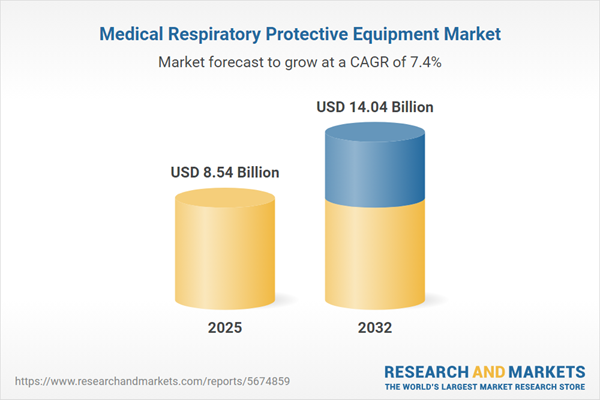Speak directly to the analyst to clarify any post sales queries you may have.
The medical respiratory protective equipment market is evolving rapidly, driven by continuous innovation, changing regulatory landscapes, and adaptive procurement strategies. Stakeholders face a dynamic environment that demands both operational agility and informed, long-term decision making.
Market Snapshot: Medical Respiratory Protective Equipment Market
The Medical Respiratory Protective Equipment Market grew from USD 7.96 billion in 2024 to USD 8.54 billion in 2025. It is expected to continue growing at a CAGR of 7.35%, reaching USD 14.04 billion by 2032. This expansion reflects a sector that is energized by heightened demand for advanced healthcare solutions, increased awareness of airborne risks, and swift integration of new technologies. Senior decision-makers must navigate a marketplace shaped by regulatory shifts, technological advancements, and international trade considerations. Opportunities for growth and risk mitigation exist at every stage from sourcing through deployment.
Scope & Segmentation
This comprehensive market research covers the evolving landscape of medical respiratory protective equipment and dissects the category from multiple viewpoints relevant to strategic planning and operational execution. Key segmentation includes:
- Product Types: Elastomeric respirator, N95 respirator, powered air purifying respirator, surgical mask
- Reusability: Disposable (N95 respirator, surgical mask) and reusable (elastomeric respirator, powered air purifying respirator)
- Applications: Non-surgical (isolation mask, procedure mask), surgical
- Patient Types: Adult, pediatric
- Materials: Non-woven fabric, silicone, thermoplastic elastomer
- End Users: Ambulatory surgical centers, clinics, dental offices, homecare, hospitals
- Regions: Americas (United States, Canada, Mexico, Brazil, Argentina, Chile, Colombia, Peru), Europe (United Kingdom, Germany, France, Russia, Italy, Spain, Netherlands, Sweden, Poland, Switzerland), Middle East (United Arab Emirates, Saudi Arabia, Qatar, Turkey, Israel), Africa (South Africa, Nigeria, Egypt, Kenya), Asia-Pacific (China, India, Japan, Australia, South Korea, Indonesia, Thailand, Malaysia, Singapore, Taiwan)
- Leading Companies: 3M Company, Honeywell International Inc., Kimberly-Clark Corporation, Ansell Limited, DuPont de Nemours, Inc., Drägerwerk AG & Co. KGaA, Alpha Pro Tech, Ltd., GVS S.p.A., Owens & Minor, Inc., Cardinal Health, Inc.
Key Takeaways: Strategic Insights for Decision-Makers
- Technological integration is advancing rapidly with sensor-equipped and smart respiratory devices gaining ground in critical healthcare settings.
- Shifting regulatory requirements are prompting manufacturers and distributors to adapt through enhanced fit-testing protocols and increased focus on reusable and sustainable product lines.
- Procurement strategies are adapting to emphasize total lifecycle value over unit price, reflecting a growing recognition of durability and environmental impact.
- Regional markets display considerable variations: mature markets prioritize compliance and partnership networks, while emerging regions focus on expanding capacity and access.
- Increased adoption of digital inventory management and real-time analytics streamlines procurement and supports rapid response to supply chain disruptions.
- Competitive advantage now hinges on collaborative innovation, regulatory alignment, and the ability to anticipate and adapt to policy changes.
Tariff Impact: Navigating Supply Chain Disruption and Price Dynamics
New United States tariff measures for 2025 add complexity to global supply chains, impacting landed costs and procurement budgets. Manufacturers are responding by diversifying suppliers, adopting near-shoring, and forming flexible agreements. End users face longer lead times and need enhanced visibility into cost structures and compliance. Successful navigation requires holistic supply chain risk management and proactive adoption of digital procurement solutions to monitor ongoing changes in tariff structures.
Methodology & Data Sources
The insights presented are derived from a multi-phased research approach. Analysis incorporates extensive secondary research, structured interviews with stakeholders across the value chain, and quantitative data compilation from trade and regulatory sources. Triangulation and peer review processes underpin data integrity and ensure comprehensive coverage of current industry conditions.
Why This Report Matters
- Enables senior leaders to identify risk and growth opportunities via segmentation, technology, and geographic analysis.
- Provides actionable insights for adapting procurement and innovation strategies amid evolving regulations and global trade shifts.
- Empowers teams to build resilient, future-ready supply chains and maintain competitive positioning in a volatile landscape.
Conclusion
The medical respiratory protective equipment market is evolving amid technology advances, regulatory changes, and shifting procurement strategies. Informed action and cross-functional alignment will be critical for leaders seeking sustainable competitive advantage and robust operational performance in years ahead.
Additional Product Information:
- Purchase of this report includes 1 year online access with quarterly updates.
- This report can be updated on request. Please contact our Customer Experience team using the Ask a Question widget on our website.
Table of Contents
3. Executive Summary
4. Market Overview
7. Cumulative Impact of Artificial Intelligence 2025
Companies Mentioned
The companies profiled in this Medical Respiratory Protective Equipment market report include:- 3M Company
- Honeywell International Inc.
- Kimberly-Clark Corporation
- Ansell Limited
- DuPont de Nemours, Inc.
- Drägerwerk AG & Co. KGaA
- Alpha Pro Tech, Ltd.
- GVS S.p.A.
- Owens & Minor, Inc.
- Cardinal Health, Inc.
Table Information
| Report Attribute | Details |
|---|---|
| No. of Pages | 191 |
| Published | November 2025 |
| Forecast Period | 2025 - 2032 |
| Estimated Market Value ( USD | $ 8.54 Billion |
| Forecasted Market Value ( USD | $ 14.04 Billion |
| Compound Annual Growth Rate | 7.3% |
| Regions Covered | Global |
| No. of Companies Mentioned | 11 |









